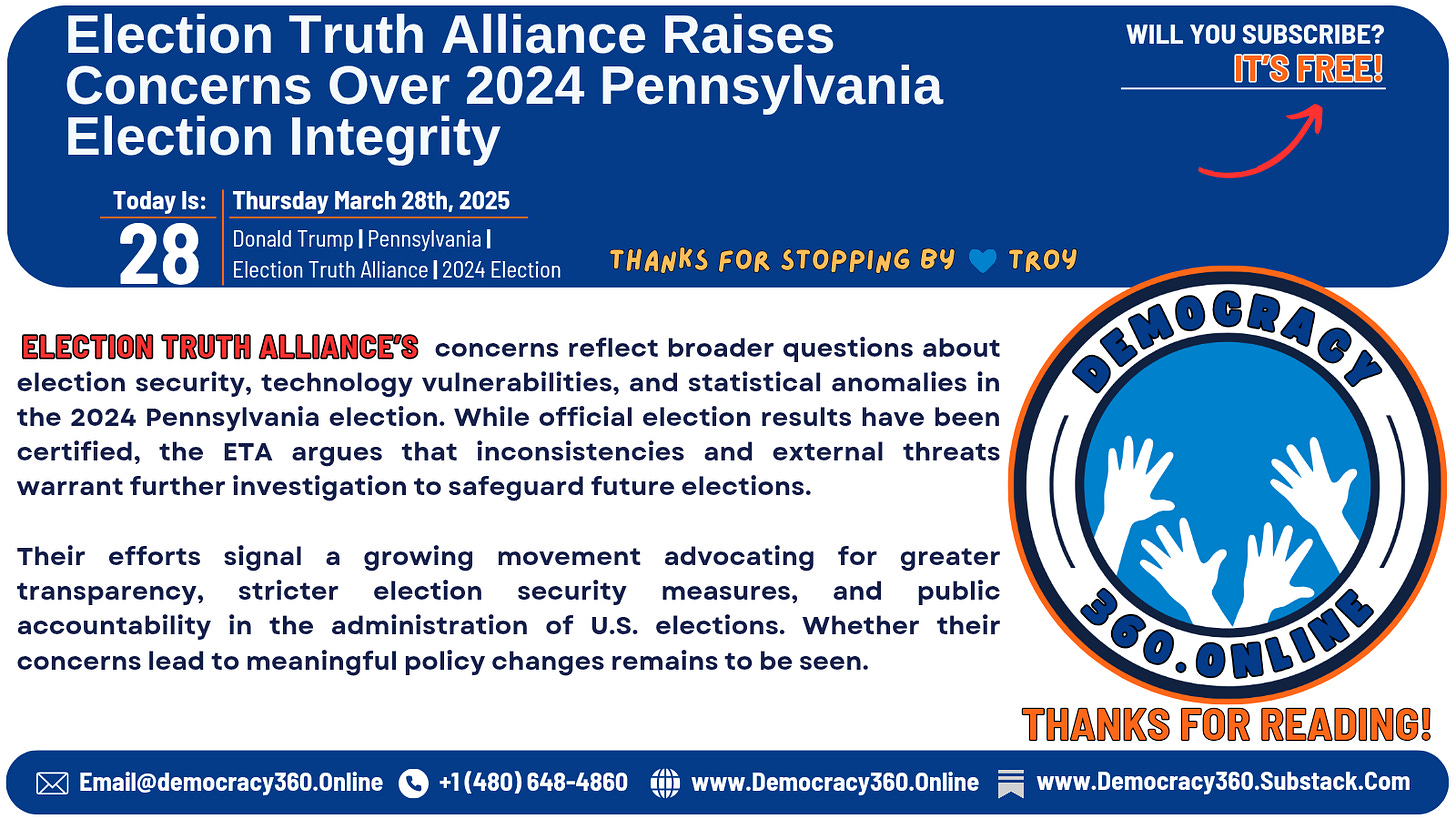In our article published on February 27, 2025, the Election Truth Alliance (ETA) raised concerns about the integrity of the 2024 U.S. Presidential election results in Nevada. Many of the issues outlined there are now surfacing in Pennsylvania, with similar concerns expanding upon ETA’s previous findings. If you haven't read that article yet, we recommend doing so before continuing here. You can find the link below:
The Election Truth Alliance (ETA), a self-described non-partisan election integrity group, has raised serious concerns about the legitimacy of the 2024 U.S. Presidential election results in Pennsylvania. The organization’s latest reports cite voting system malfunctions, statistical anomalies, and external threats, advocating for increased scrutiny, audits, and legal action to address what they believe are unresolved questions about the election’s integrity.
Key Issues Identified by the Election Truth Alliance
1. President-Elect Trump’s Remarks on Voting Systems
The ETA has drawn attention to comments made by President-Elect Donald Trump regarding “vote-counting computers” and his victory in Pennsylvania. During a pre-inauguration rally, Trump referenced tech entrepreneur Elon Musk’s knowledge of voting systems, a statement the ETA finds concerning.
Nathan Taylor, ETA’s Executive Director of Advocacy and Public Engagement, warns that “if tabulators have been compromised, we have a huge problem with the integrity of our elections.” The ETA calls for further scrutiny of Pennsylvania’s election infrastructure in light of these remarks.
2. Widespread Voting System Malfunctions
The organization highlights reports of machine errors affecting ballot scanners and vote tabulators in at least 20 of Pennsylvania’s 67 counties. According to their findings:
Most failures involved ballot scanners not properly reading votes, an issue attributed primarily to Election Systems & Software (ES&S) and Dominion Voting Systems machines.
These companies, the ETA argues, were the targets of multiple election security breaches between 2020 and 2024.
The high volume of malfunctions on Election Day raises questions about whether these issues were coincidental or indicative of deeper vulnerabilities.
3. Alleged Voting System Vulnerabilities
Citing cybersecurity experts, the ETA references past academic studies warning of the ease with which malicious software can be installed on voting machines. Their report claims that a single compromised machine could manipulate votes with little risk of detection and that altering a machine’s software can take as little as one minute with physical access.
These concerns align with previous calls for increased security measures in electronic voting infrastructure, including bipartisan proposals for more rigorous audits of voting systems.
4. Unusual “Drop-Off Vote” Patterns
The ETA’s data analysts have identified what they describe as “significant drop-off vote irregularities”—cases where the number of votes cast in the Presidential race was disproportionately lower than expected compared to down-ballot races. Their analysis found:
In 47 out of 67 Pennsylvania counties, Democratic Candidate Kamala Harris received fewer votes than Senator Bob Casey, Jr., a pattern the ETA calls “atypical” compared to previous elections.
In 20 counties that reported machine errors, 17 also exhibited this drop-off trend, potentially linking voting system malfunctions with irregular vote tallies.
The only county where the Republican candidate showed a similar drop-off pattern was Chester County, a statistical outlier in the data.
5. Discrepancies in Voter Turnout Relative to Party Registration
ETA analysts also point to inconsistencies between voter registration numbers and final vote counts. In Fayette County, for example:
Kamala Harris received 39% fewer votes than the total number of registered Democrats, a gap the ETA considers statistically significant.
Donald Trump received 6% more votes than the number of registered Republicans, raising questions about crossover voting patterns or potential irregularities.
A hand recount requested by local election officials was halted by a court petition, leaving the issue unresolved.
6. External Threats and Election Day Disruptions
Beyond concerns over voting systems, the ETA highlights threats to Pennsylvania’s election infrastructure on Election Day:
Bomb threats were called into over 30 counties, targeting polling places and election offices, delaying both voting and ballot counting in some regions.
According to the ETA, the FBI confirmed that more than 200 bomb threats were linked to Russian email domains.
The U.S. Treasury Department recently sanctioned Iranian and Russian actors for attempting to interfere in the election, raising further questions about potential external influences.
ETA’s Call for Action
In response to these findings, the Election Truth Alliance is urging state and local officials to launch an investigation, including:
Hand audits of paper ballots to verify official election results.
Legal challenges in key counties where discrepancies suggest possible vote manipulation.
Recruitment of volunteers and attorneys to assist in election transparency efforts.
The group emphasizes the importance of “common-sense election hygiene”—including system audits, recounts, and integrity checks—to restore public confidence in Pennsylvania’s electoral process.
OFFICIAL PRESS RELEASE INFORMATION:












